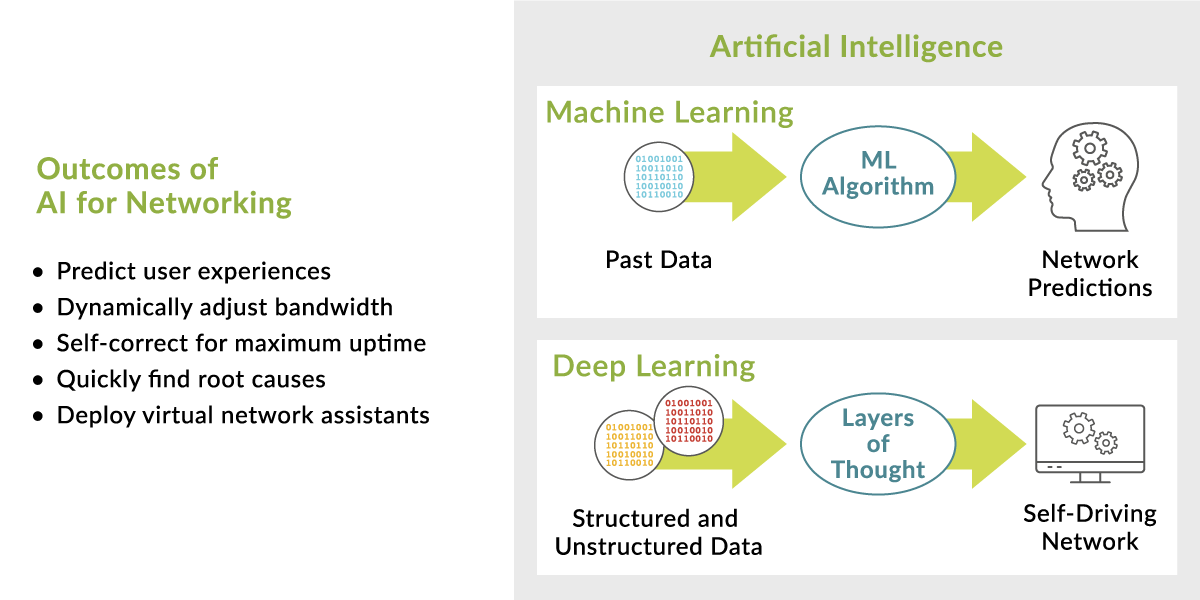The
purest definition of artificial intelligence (AI) is software that
performs a task on par with a human expert. AI plays an increasingly
critical role in taming complexity for growing IT networks.
The
proliferation of devices, data, and people has made IT infrastructures
more complex than ever to manage. Given that most IT budgets are flat or
shrinking, businesses need a way to manage this complexity, and many
are now looking to artificial intelligence for help.
For
AI to be successful, it requires machine learning (ML), which is the
use of algorithms to parse data, learn from it, and make a determination
or prediction without requiring explicit instructions. Thanks to
advances in computation and storage capabilities, ML has recently
evolved into more complex structured models, like deep learning (DL),
which uses neural networks for even greater insight and automation.
Natural language processing (NLP) is another trend that’s driven recent
AI advancement, particularly in the area of the virtual home and IT
assistants. NLP uses vocal and word-based recognition to make
interfacing with machines easier via natural language cues and queries.

Without
the right AI strategy, IT simply can’t keep up with today’s stringent
network requirements. Here are several technology elements that an AI
strategy should include.
- Data: Any meaningful AI solution begins with massive amounts of quality data. AI continually builds its intelligence over time through data collection and analyses. The more diverse the data collected, the smarter the AI solution becomes. In the case of real-time applications involving highly distributed “edge” devices, such as IoT and mobile devices, for example, it’s crucial to collect data from every edge device in real time, then quickly process it locally or very nearby in an edge computer or the cloud using AI algorithms.
- Domain-specific expertise: Whether helping a doctor diagnose cancer or enabling an IT administrator to diagnose wireless problems, AI solutions need labeled data based on domain-specific knowledge. These metadata chunks help the AI break the problem down into small segments that can be used to train the AI models. This task can be achieved using design intent metrics, which are structured data categories for classifying and monitoring the wireless user experience.
- Data science toolbox: Once the problem has been divided into domain-specific chunks of metadata, this metadata is ready to be fed into the powerful world of ML and big data. Various techniques, such as supervised or unsupervised ML and neural networks, should be employed to analyze data and provide actionable insight.
- Virtual network assistant. Collaborative filtering is an ML technique that many people experience when they select a movie on Netflix or buy something from Amazon and receive recommendations for similar movies or items. Beyond recommendations, collaborative filtering can be applied to sort through large data sets and identify and correlate those that form an AI solution to a particular problem.
In
AI for networking, the virtual network assistant might function in a
wireless environment as a virtual wireless expert that helps solve
complex problems. Imagine a virtual network assistant that combines
quality data, domain expertise, and syntax (metrics, classifiers, root
causes, correlations, and ranking) to provide predictive recommendations
on how to avoid problems and to offer actionable insights on how to
remediate existing issues. It can learn wireless network nuances and
respond to questions such as, “What went wrong?” and “Why did that
happen?” These are the types of automated advances that AI is enabling.
Real-World Benefits
With
AI comes a lot of hype, and that can be confusing and create false
expectations. But AI for networking is very real and is already
providing substantive value to companies in almost every industry. There
are many examples of how AI-driven networks can help your environment.
- Detecting time series anomalies. Many devices running on today’s networks were invented 20 years ago, and they don’t support current management messages. AI can detect time series anomalies with a correlation that allows network engineers to quickly find relationships between events that would not be obvious to even a seasoned network specialist.
- Event correlation and root cause analysis. AI can use various data-mining techniques to explore terabytes of data in a matter of minutes. This ability lets IT departments quickly identify what network feature (for instance, OS, device type, access point, or switch) is most related to a network problem, accelerating problem resolution.
- Predicting user experiences. Today, application bandwidth apportionment happens largely through capacity planning and manual adjustments. Soon, though, AI will be able to predict a user’s Internet performance, thus allowing a system to dynamically adjust bandwidth capacity based on which applications are in use at specific times. Manual planning will give way to predictive analysis that’s informed by historical trends and current calendar information.
- Self-driving. AI enables IT systems to self-correct for maximum uptime and provide prescriptive actions as to how to fix problems that occur. In addition, AI-driven networks can capture and save data prior to a network event or outage, helping to speed troubleshooting.
Today,
the convergence of several different technologies is enabling AI to
completely disrupt the networking industry with new levels of insight
and automation. AI helps lower IT costs and it assists businesses in
achieving their goal of delivering the best possible IT and user
experiences.
No comments:
Post a Comment